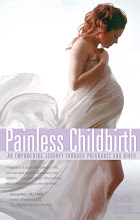Contact: Berna Diehl
202-591-4045
Berna@JonesPA.com
For Release: May 27, 2010
New Data Show Connection Between Childbirth and Spirituality
- Spiritual beliefs may have a place in the clinical assessment for women having babies -
WASHINGTON—While having a safe and healthy birth is typically a primary concern for pregnant women, new research shows that most women view childbirth as a spiritual experience as well. The just-published research shows that women across diverse cultures correlate having a baby with “growing closer to God.”The study, published in the spring issue of the Journal of Perinatal Education, found that understanding the spiritual dimensions of childbirth is essential in clinical settings. As such, authors of the study recommend clinicians include the question, “Do you have any spiritual beliefs that will help us better care for you?” during their clinical assessment.
“Childbirth and motherhood provide many women with an ideal context in which to recognize the spiritual aspect of their lives,” said Lynn Clark Callister, R.N., Ph.D., FAAN, a professor of nursing at the Brigham Young University College of Nursing and study co-author. “Our research illustrates that for most women, childbirth is a deeply spiritual experience. As healthcare providers, we need to recognize and support this evidence, and listen to women’s voices to guide their care.”
In their study titled “Spirituality in Childbearing Women,” authors Callister and Inaam Khalaf, R.N., Ph.D., dean and professor of nursing at the University of Jordan Faculty of Nursing, discovered five themes in a secondary analysis of the published and unpublished narrative data collected over the past 20 years from about 250 culturally diverse women.
“This study is both insightful and intuitive,” said Sharon Dalrymple, president of Lamaze International. “It’s no surprise to see a woman’s spirituality is an important part of her well-being, but it’s interesting to consider how this information can be used by women and their healthcare professionals to enrich and further empower women when they are giving birth.”
The themes that emerged in the study included: childbirth as a time to grow closer to God, the use of religious beliefs and rituals as powerful coping mechanisms, childbirth as a time to make religiosity more meaningful, the significance of a Higher Power in influencing birth outcomes and childbirth as a spiritually transforming experience.
“At Lamaze, we understand childbirth is not just another day in a woman’s life, childbirth is a major life event and it can be a transformative experience that profoundly affects women and their families for generations to come,” continued Dalrymple. “It is important to acknowledge the inherently spiritual nature of childbirth and create a birth environment that lets women give birth simply and safely. A key component to creating this environment is avoiding unnecessary medical interventions.”
To support women in their efforts to have safe and healthy births, Lamaze International developed the Six Healthy Birth Practices based on recommendations by the World Health Organization and backed by extensive research that support a woman’s natural ability to give birth. The Six Healthy Birth Practices are:
•Let labor begin on its own
•Walk, move around and change positions throughout labor
•Bring a loved one, friend or doula for continuous support
•Avoid interventions that are not medically necessary
•Avoid giving birth on your back and follow your body's urges to push
•Keep mother and baby together; it's best for mother, baby and breastfeeding
To learn more about Lamaze’s Six Healthy Birth Practices, please enroll in a Lamaze childbirth education class and visit http://www.lamaze.org/Default.aspx?tabid=251.
About Lamaze International
Lamaze International promotes a natural, healthy and safe approach to pregnancy, childbirth and early parenting practices. Knowing that pregnancy and childbirth can be demanding on a woman’s body and mind, Lamaze serves as a resource for information about what to expect and what choices are available during the childbearing years. Lamaze education and practices are based on the best and most current medical evidence available. Working closely with their families, health care providers and Lamaze educators, millions of pregnant women have achieved their desired childbirth outcomes using Lamaze practices. The best way to learn about Lamaze’s steps to a safe and healthy birth is to take a class with a Lamaze certified instructor. To find classes in your area, or for more information visit www.lamaze.org.
About the Journal of Perinatal Education
Published quarterly by Lamaze International, The Journal of Perinatal Education is the leading peer-reviewed journal specifically for childbirth educators. Through evidence-based articles, the journal keeps educators informed about research and its implications for practice. Journal features provide practical resources and advice educators can use to enhance the quality and effectiveness of their teaching to prepare expectant parents for birth.





